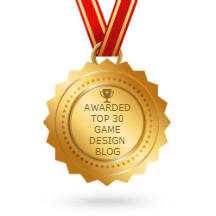The Stunning Eye of the Prototyping Process
In a very intriguing passage about the values of lightness in literary creation, Italo Calvino takes a look at how Perseus overcame the terrifying Medusa. The answer, according to Calvino, lies in the indirect approach that Perseus adopted as he fought the monster. Perseus did not carry out his fight against her, but around her (1988: 4-7). I’d like to claim that this principle provides us with a metaphor of the prototyping process.
Consider the diagram below:

Diagram 3: The Stunning Eye and the Safe Path around it. This diagram builds upon the prototyping stages formulated in Tracy Fullerton’s Game Design Workshop, Second Edition: A Playcentric Approach to Creating Innovative Games
The safest way -if you don’t want to get stunned- is to avoid the ‘eye’ of the prototyping process (the Everything). Instead you have to walk carefully around the ‘eye’, and stay on the triangular track that leads around it and only take one step at a time when you move between neighboring areas.
…Until here, the focus of our voyage was on control. We explored the ways to foster a meaningful level of exactitude in our prototypes. We discussed methods on how to survive the complexities of prototyping. We realized that it is not only possible, but also necessary to exercise a certain level of control over the prototyping process. Maybe it is now the time to sail into the rather untamed waters of prototyping. I feel a fresh wind coming up and I’d say let’s not miss this chance and sail into more playful waters.
Prototyping with a Portfolio Philosophy
In the preface to Emily Dickinson’s Collected Poems
It can be said that the “philosophy of the portfolio” is vital in the prototyping process, too. As much as there is a need for control, there is also a need for just forgetting about goals and deadlines and other restrictions for a while and see where the expression of our own minds carries us. As dangerous as this might look to a producer or all other “sane” members on a development team, there opens itself to us a new gate to unimagined potentialities.
Dickinson is known for the various renderings of her poems. Crafting a poem was an open process of writing many a poems that could have been that poem (or not). The process was free from any marketing concerns. In this free-flow process, there came to day a multitude of potentialities which served as a ground for “happy accidents”, as Elizabeth Jennings (in Dickinson; 1991: 385) calls them. This was not so much about reaching an end product as it was about maintaining an energy field in flux which in it held together the echoes of all previous prototypes (and those to come). Despite the emphasis on the process over the product, it is especially worth mentioning that with over 2000 poems, Dickinson has been a very productive writer.
We will name here two lines of thought in creativity and innovation -both being in favor of vibration, flux, and multitude- that connect to this fruitful experimental “philosophy of the portfolio”:
One of the lines can be exemplified in Roland Barthes’ idea of a mathesis singularis (in Calvino; 1988: 65), the science of the partial (in contrast to mathesis universalis, the science of universals). Another example within this line of thought can be found in Robert Musil’s novel Der Mann Ohne Eigenschaften (The Man without Qualities
The other line connects to the modern literary movement of creating a “machine for multiplying narratives” (Calvino; 1988: 120) as being observed in some of the works of Raymond Queneau (A Hundred Billion Poems) and Georges Perec (Life: A User's Manual
It is obvious that the “philosophy of the portfolio” might serve as a basis for a “Workshop of Potential Gameplay”. Getting this sort of philosophy incorporated into the formal processes of the profit-seeking industries might be also one of the ways to answer the repeated calls for “art games”.
…The winds were generous, my friends, and they carried us along the vast seas of prototyping. Is it only me, or do you, too, smell the scent of flowers and trees? Could it be that these green hills at a distance are the hills of our beloved lands? And isn’t that a bay over there, the bay of our city, with all those ships and buildings embracing each other? It seems like we will soon be at home; and now it’s the waves of excitement and joy that seem to carry our ship. So let us be quick and clear up the remaining issues, since we will have to part soon.
Altug Isigan is a scholar at the Eastern Mediterranean University, Department of Radio-TV and Film, in sunny Famagusta, Cyprus, where he is writing a dissertation on narrative in games. You can read more of his work at his blog, the Ludosphere.







0 comments:
Post a Comment